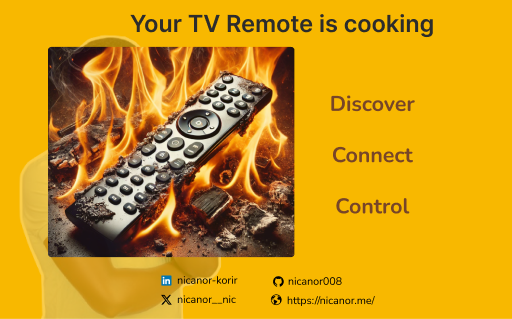Developing a TV Remote Control App in JS
 Nicanor Talks Web
Nicanor Talks Web
I've been working on small #WeekendBuild projects to advance my hard skills in building production-ready simple projects. Developing a TV remote control app using JavaScript and Node.js is an exciting project that combines software development with hardware control.
The idea of developing a TV remote control app came about after losing our TV remote and not finding a suitable app that works for all my preferences.
How Remote Controls Work
Remote controls have been a staple in household electronics for decades. They work by sending signals to the TV, which are then interpreted as commands such as changing the channel, adjusting the volume, or turning the TV on/off. These signals can be transmitted through various methods:
Infrared (IR): Uses light waves to transmit signals.
Bluetooth: Uses radio waves for communication.
WiFi: Utilizes the home network for sending commands.
TV Connection Protocols
TVs support various protocols to communicate with remote controls and other devices. The most common ones are:
Consumer Electronics Control (CEC): Part of the HDMI standard, allowing devices to control each other
WiFi Direct: Allows devices to connect directly without needing a WiFi network
Bluetooth Low Energy (BLE): Enables energy-efficient connections between devices
Connection Types
Infrared (IR)
Infrared remote controls use light waves in the infrared spectrum to transmit signals. An IR remote emits a series of infrared light pulses, which are encoded with specific commands. These pulses are received by an IR sensor in the TV, which decodes the signals and performs the corresponding actions.
Characteristics of IR Connection:
Line of Sight: IR remotes require a clear line of sight between the remote and the TV. Obstacles like furniture can block the signals.
Short Range: The effective range of IR remotes is typically up to 10 meters.
Simplicity: IR technology is simple and cost-effective, making it widely used in traditional remote controls.
IR Connection Limitations:
Directional Use: IR remotes need to be pointed directly at the TV's IR sensor.
Interference: Sunlight or other strong light sources can interfere with IR signals.
Bluetooth
Bluetooth remotes use radio waves to communicate with the TV. They operate in the 2.4 GHz frequency band, which allows them to transmit signals without needing a direct line of sight. Bluetooth Low Energy (BLE) is often used for its energy efficiency.
Characteristics:
No Line of Sight Required: Bluetooth remotes can work through walls and obstacles, providing more flexibility in use
Medium Range: The range of Bluetooth is generally around 10 meters but can vary based on the specific implementation and environment
Two-Way Communication: Bluetooth supports bidirectional communication, allowing for more complex interactions, such as receiving feedback from the TV
Limitations:
Interference: Other devices operating in the 2.4 GHz band (e.g., WiFi routers, microwaves) can cause interference
Pairing Required: Bluetooth devices need to be paired before they can communicate, which adds an extra step for users
Wi-Fi
WiFi-based remote controls use the home network to send commands to the TV. These commands are typically sent using standard network protocols such as HTTP or WebSockets. Many smart TVs come with built-in WiFi modules that allow them to connect to the home network and communicate with other devices.
WiFi connection Characteristics:
Wide Range: The range of WiFi is much larger than IR and Bluetooth, often covering the entire home.
Complex Interactions: WiFi enables more sophisticated interactions, such as integrating with smart home systems or controlling the TV from a mobile app.
Network Dependency: WiFi remotes rely on the home network, so a stable and robust network is essential for consistent performance.
WiFi connection Limitations:
Setup Complexity: Setting up WiFi-based control can be more complex and may require network configuration.
Latency: Depending on network conditions, there might be some latency in sending commands.
Security: WiFi networks can be vulnerable to security issues, so proper encryption and security measures are essential.
In a nutshell:
Infrared (IR) remotes are simple, cost-effective, and require a line of sight, making them suitable for traditional remote control uses.
Bluetooth remotes offer more flexibility with no line of sight requirement and bidirectional communication but require pairing and can face interference.
WiFi remotes provide the most advanced capabilities, allowing for integration with smart home systems and control from anywhere within the network range, but they rely on a stable network and have more complex setup requirements.
Weekend Build Project
While working on my weekend build project, I had to the privilege of using different tools for connection protocols. I used all three connection types: IR, Bluetooth and WiFi.
I'll be sharing the complete solution in my next post series. If you want to keep an eye out and be up to date on the progress, take a look at this tv-remote-control repo
Subscribe to my newsletter
Read articles from Nicanor Talks Web directly inside your inbox. Subscribe to the newsletter, and don't miss out.
Written by

Nicanor Talks Web
Nicanor Talks Web
Hi there! I'm Nicanor, and I'm a Software Engineer. I'm passionate about solving humanitarian problems through tech, and I love sharing my knowledge and insights with others.